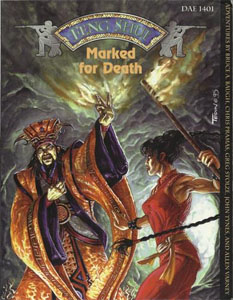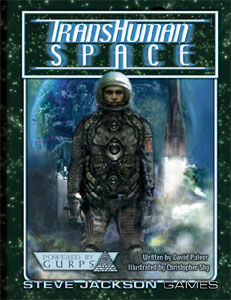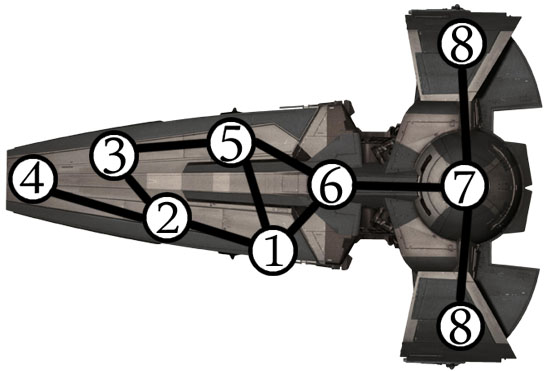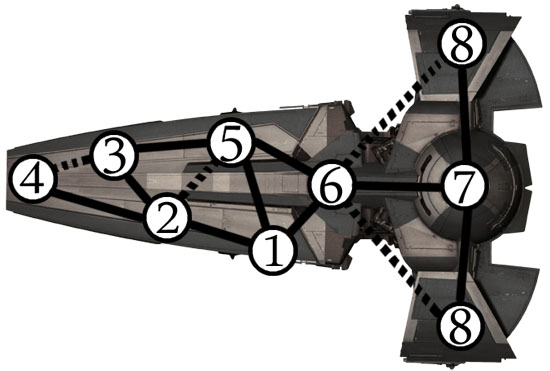As a final rumination on the subject of game structures, I want to discuss player-known and player-unknown game structures and the differences between the two in actual play.
Let me demonstrate what I’m talking about by way of example.
THE UNKNOWN HEX
In the earliest hexcrawling structures, the players were supposed to be aware of the hexes. Volume 3: The Underworld & Wilderness Adventures for OD&D, for example, reads, “When players venture into this area they should have a blank hexagon map, and as they move over each hex the referee will inform them as to what kind of terrain is in that hex.”
In designing the structure I use for hexcrawling, on the other hand, I specifically eschewed this approach: Although I found the abstraction of the hex map useful in many ways, I didn’t want the players to directly interface with that abstraction. Instead, I wanted them to interact with the game world.
So while I used the abstraction of the hex map for its convenience in mapping and keying, my players had to figure out how to navigate the world purely from the view point of their characters.
The original version of hexcrawling is a player-known game structure: They can see, understand, and even manipulate the game structure that you’re using to represent the game world. Most combat systems are another excellent example of player-known game structures.
My version of hexcrawling is a player-unknown game structure: They perceive only the game world and don’t know exactly what structures you’re using to prep and run that world. Another common example of a player-unknown game structure are random encounters: Did they run into goblins in that hallway because the encounter was keyed there or because the GM rolled a random encounter?
USING PLAYER-UNKNOWN STRUCTURES
My decision to obfuscate my hexcrawling procedures is not unusual for me. As a GM, I’m generally trying to find simple methods of organizing my prep work so that it can be easily and efficiently referenced and used during play. But I don’t necessarily want my players to see the structure that I use: I want them to see the messy, chaotic world that their characters live in.
The method I refer to a “The Second Track” in Advanced Node-Based Design is an example of this: I organize two distinct and easy-to-manage groups of nodes, but then I mix them together in play to create a more complex reality.
I discussed another example as “Minor Elevation Shifts” as part of the Xandering Techniques: “When the PCs come to a staircase they may naturally assume that they are going up or down to a new level of the dungeon. But by including minor elevation shifts within the topography of a single dungeon level you can confound their expectations … These techniques aren’t just a matter of confusing the players’ mapping. You are disrupting their ability to intuit the organization of your maps by analyzing the reality of the game world. While maintaining clean and simple maps for your own use and reference, you are creating a world that not only seems more dynamic and complex, but actually is more dynamic and complex.”
More generally, if the players don’t know the structure you’re using then they can’t engage the structure: Instead, they have to propose actions in-character.
See if you can imagine for a moment what combat would be like if the players had no idea what the underlying structure of the game was. I don’t just mean a scenario in which the GM is keeping their hit point totals secret from them: I mean that the players don’t know what rounds are; they don’t know what attack rolls are; they don’t know what hit points are. What effect would that have on how combat is experienced at the game table?
On a similar note, running a new game structure in a player-unknown configuration can be a great method for diagnosing inadequacies, shortcomings, and dissociations in the structure. If you come to your players and say, “Here’s a system for Gee-Whizzing and it has rules for A, B, and C.” Then your players may focus exclusively on the options that have been presented to them.
But if you just come to your players and say, “Let’s do some Gee-Whizzing.” Then your players will be free to propose any action that occurs to them: If they stick to A, B, and C then you’ve done your job well. If they’re proposing D, E, F, and G then you’ve got some holes to fill.
Similarly, if you find that your structure keeps expecting the players to make decisions that they aren’t making (or that they can’t make without being aware of the structure), then that’s a huge tip-off that your structure is dissociated.
USING PLAYER-KNOWN STRUCTURES
This is not to say, however, that player-unknown structures are the be-all and end-all of gaming. On the other end of the spectrum, player-known structures are specifically useful because they allow players to make decisions informed by the game structures in play.
In my hexcrawling structure, for example, players must select their mode of travel: Normal, Hustling, Cautious, or Exploring.
(Normal movement has no modifiers. Hustling increases navigation DCs. Cautious movement is made at ¾ normal speed, navigation DCs are decreased, and the chance for non-exploratory encounters is halved. Finally, while exploring, characters move at ½ normal speed and the chance for encounters is doubled.)
For roughly a dozen sessions or so, I kept this structure hidden from the players: Instead, I applied the appropriate mode of travel based on the actions they proposed. (For example, if they said that they were going to start moving carefully through the woods in order to avoid encountering any of the orc warbands they knew were looking for them, then I would slot them into the “cautious” mode of travel.)
Eventually, however, I concluded that it made more sense to make this a player-known structure: First, because the players were assuming – in the absence of additional information – that these types of decisions were irrelevant in the game structure I was using. (And because of this false intuition of the game structure, they stopped feeding me the cues I was using to assign modes of travel.) Second, because choosing a mode of travel had a significant impact on the efficacy of navigation in the system. (Hiding this structure from them actually made them less competent than their characters.)
You can see a similar principle in the familiar debate of whether or not GMs should tell their players the target number for an action check. (My opinion is that you should only obfuscate the target number if that obfuscation mirrors a lack of information on the part of the character. Otherwise, providing the DC is the quickest way to overcome the vast difference in bandwidth between the character’s perception of the world around them and the player’s perception of that world. For example, a character standing in front of a chasm can actually see the chasm. The player, on the other hand, is completely dependent on a very narrow band of audio communication from the GM.)
But I digress.
As a final point of consideration in player-known structures, consider the Point of First Contact in that structure. As described in an essay at D-Constructions:
For better or for worse, most RPGs have freeform moments and structured moments, and it’s a really good idea to think about how the latter start. […]
The first die does get a lot of focus in play because it’s the break moment. It’s the moment you start concentrating and reach for your first contact with the rules. So it pops up in your mind and yells “THIS IS IMPORTANT”. To an extent, therefore, it doesn’t matter what your CORE mechanic is because your first gets more attention. […]
It’s worthwhile, therefore, to make sure your first contact IS important to the kind of game you want to run. In Smallville your first die is your value – what you believe in, why you care about this struggle at all. In Marvel it’s what kind of team you’re in – are you the kind of person who performs better in a team, with a buddy, or solo. Right way we have something central to Marvel’s enduring dynamic.
What’s your first point of contact? In every sense?
IN CONCLUSION
This has been a very long series of essays. It’s touched on a lot of different subjects (which is perhaps unsurprising, given that the topic is one that lies at the heart of virtually every moment at your gaming table). But if you gain absolutely nothing else from it, I hope you can take away two important points:
First, I think a lot of the linear, railroaded scenarios that we see in roleplaying games are the result of GMs who have a limited (or nonexistent) toolset. Often I think GMs don’t even realize that these types of tools exist. But they do exist and there’s nothing complex or mysterious about them. Once you know they exist, they’re not even particularly difficult to master.
Second, if you’re a GM, I think you’ll benefit greatly from consciously thinking about the game structures you’re using: Innovate. Experiment. Create. Share. Playtest.
One of the most exciting thing about the Old School Renaissance for me has been its role in rediscovering highly effective game structures that had largely been forgotten by the mainstream gaming community. Over the past few years, we’ve seen how much fresh creativity and original gameplay can be generated out of tapping a robust game structure like hexcrawling that has lain dormant for years.
But I think that’s barely scratching the surface. If we can get stuff like Carcosa and Points of Light and Kingmaker out of hexcrawling, what else have we been missing out on?
Game structures are merely ornately-wrought keys. The really interesting stuff is what lies beyond the doors those keys will unlock.
FURTHER READING
Hexcrawls
Thinking About Urbancrawls
Gamemastery 101
Game Structures – Addendum: Katanas & Trenchcoats















